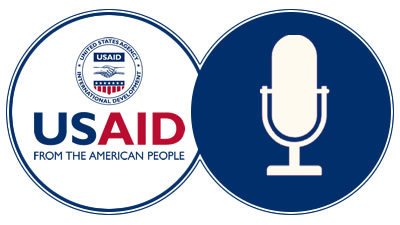
December 2017
2017: A Year in Review
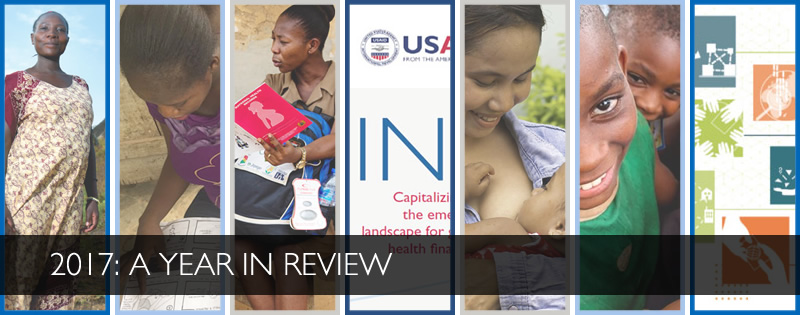
As 2017 ends, we share some key global health events, milestones and highlights from the past 12 months of our efforts at the U.S. Agency for International Development (USAID) to prevent child and maternal deaths, control the HIV/AIDS epidemic and combat infectious diseases.
U.S. President's Malaria Initiative Expands
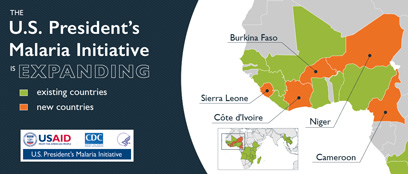
USAID Administrator Mark Green announced the U.S. President’s Malaria Initiative (PMI) will launch new country programs in Cameroon, Cote d'Ivoire, Niger and Sierra Leone and expand the existing program in Burkina Faso. These countries carry some of the highest burdens of malaria in the region. PMI's country expansion will benefit almost 90 million additional people at risk of malaria. With the addition of these five countries, the U.S. contributions to effective malaria prevention and control will help protect more than half a billion people from malaria, stretching from the Sahel to the Horn of Africa and down to Southern Africa.
- Learn about PMI’s recent results in the Eleventh Annual Report to Congress [PDF, 6.4MB].
- Read the Executive Summary [PDF, 1.5MB].
- View PMI By the Numbers [PDF, 652KB].
Prioritizing Our Shared Global Health Security
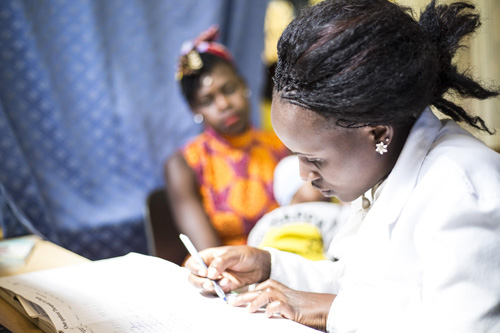
The risks posed by outbreaks of infectious disease are not new, but in our interconnected world, they are intensifying. In 2017, there were outbreaks of pathogens that had the potential to spread across regions and even the world, including Ebola, Marburg, bubonic plague, Cholera, Zika, diphtheria and the ongoing novel Middle East Respiratory Syndrome (MERS) coronavirus – an important reminder of the importance of early detection and response, community engagement and strong coordination, surveillance, and sufficient laboratory capacity for timely diagnosis. The United States is working with partner countries to improve public health systems long before an outbreak starts. Global Health investments are vital to U.S. national security interests and the prosperity of the United States.
- Advancing the Global Health Security Agenda: Progress and Early Impact from U.S. Investment [PDF, 2.0MB]
Fighting Ebola Grand Challenge
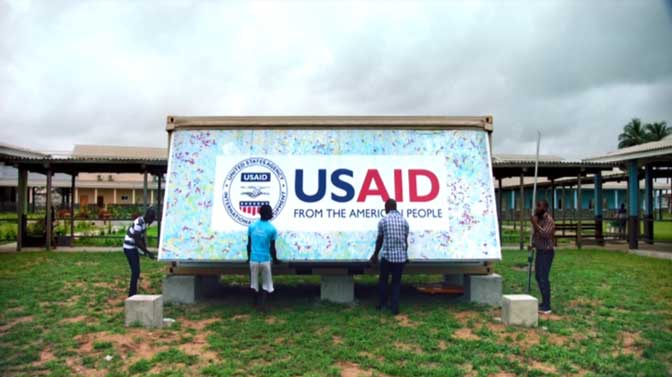
Fighting Ebola Grand Challenge innovation success story: In 2017, Fighting Ebola Grand Challenge innovator Baylor College of Medicine deployed their Emergency Smart Pod to ELWA Hospital in Liberia. The Emergency Smart Pod is a portable, lightweight healthcare setting that can be expanded to a full-size unit in less than five minutes with just four people. ELWA used the Pod to prepare Ebola survivors for cataract surgeries in September 2017, and going forward, the Pod will be used as an isolation unit for infectious patients. To learn more about the Fighting Ebola Grand Challenge and the Pod, watch this video.
Unprecedented Global Crises
2017 was marked by complex and challenging humanitarian emergencies across the globe that further destabilized our world and eroded hard-won health gains. Cholera, famine and civil war tormented Yemen. Humanitarian crises and conflict rocked South Sudan, Democratic Republic of the Congo, Syria, Iraq, Myanmar and the Greater Sahel and Lake Chad Basin; and famine spread in Nigeria, Somalia, South Sudan and Yemen, having an impact on hundreds of millions of people. USAID is helping respond to, counter, and prevent complex threats and crises around the globe. Similar to previous grand challenges for health, USAID will hold a Humanitarian Assistance Grand Challenge in early 2018 to bring to bear private sector innovations to help us tackle these challenges.
Acting on the Call Summit

The 2017 Acting on the Call Summit in Addis Ababa, Ethiopia for mothers and children hosted by the governments of Ethiopia and India gathered participants from 24 countries to demonstrate global commitment and continued momentum toward improving child and maternal health. The 2017 Acting on the Call Report details the progress made in 25 priority countries and examines how a focus on core functions of health systems will help accelerate progress by delivering essential, quality health services and ensuring that they reach the most vulnerable and underserved populations. Health systems consist of all people, institutions, resources and activities that have an impact on the health of a population.
- Country stories on USAID's maternal and child survival efforts.
- Fact sheet [PDF, 2MB] on 2017 Acting on the Call Report
- View American Institutions Partnering with USAID to Advance Global Health.
- Photo essay: How Will We Save 600,000 Women’s Lives by 2020?
Malaria Progress Slows, Reverses in Some Cases
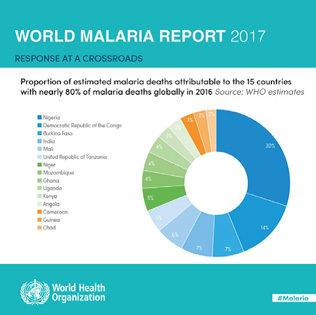
Although substantial progress in scaling up malaria control interventions continues, progress on reducing malaria cases and deaths has slowed, and in some countries, reversed, according to the 2017 World Malaria Report. An estimated 216 million cases and 445,000 deaths from malaria occurred in 2016, largely unchanged from 2015. Just 15 of the 91 countries with indigenous malaria transmission now carry 80 percent of the global malaria burden. These include the largest and most complex countries, such as Nigeria and Democratic Republic of Congo, pointing to the need to further intensify efforts in high-burden countries and highlighting the challenges of making progress in areas of social instability.
- Learn more about the present state of the battle against malaria in WHO’s 2016 World Malaria Report.
Cambodia and Laos Eliminate Trachoma
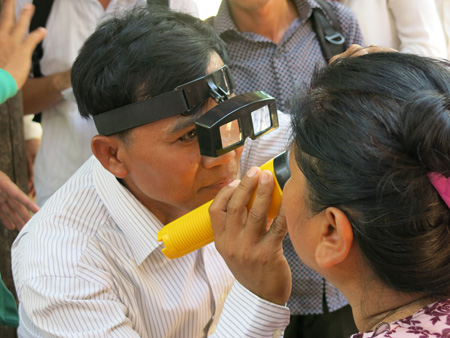
Cambodia and Laos became only the fourth and fifth endemic countries globally to have eliminated trachoma as a public health problem. Trachoma is a blinding eye disease caused by a bacterial infection that can cause the eyelashes to turn inwards. Trachoma is generally spread from person-to-person through contact with bacteria-carrying flies and contaminated hands. USAID is a global leader in elimination and control of seven of the most prevalent Neglected Tropical Diseases (NTDs), including trachoma. Together with partners, USAID has supported the delivery of more than 2 billion treatments to nearly 1 billion people across 25 countries over the past 10 years. As a result of these efforts, 84 million people now live in areas where treatments are no longer required for trachoma.
Drug Donation Program Marks a Decade
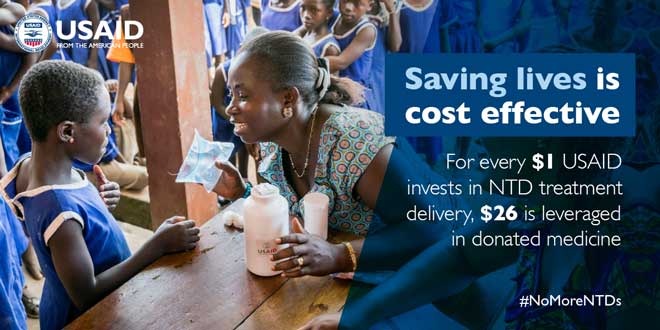
2017 marked a decade of partnership between USAID and several pharmaceutical companies that have given more than $15.7 billion worth of life-changing drugs free of charge to countries where USAID is supporting mass treatment campaigns. USAID thanks the generous support from our private sector partners Eisai, GlaxoSmithKline, Johnson & Johnson, Merck & Co., Merck Serono, and Pfizer, Inc. Every $1 invested by USAID in NTDs leverages $26 in pharmaceutical donations for mass treatment campaigns, thus reducing USAID's treatment cost to 63 cents per person, a best buy in public health.
- 10 Years of Progress brochure, featuring examples of the program's successful public-private partnership
- NTD donor landscape, which visually maps out the focus of donor investments
Antimicrobial Resistance Concerns Grow
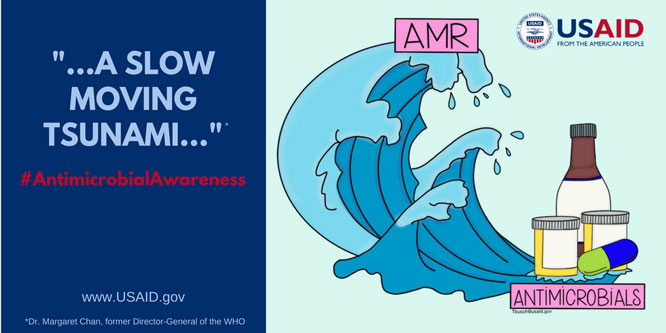
Image credit: Tobey Busch, USAID
The overuse, underuse or misuse of medicines results in wastage of scarce resources and widespread health hazards. While antimicrobial resistance (AMR) is a global problem, low- and middle-income countries are particularly at risk as local health systems are often ill-equipped to address the major complications associated with resistant infections or the multidimensional drivers which cause them. Multidrug-resistant tuberculosis (MDR-TB) is one of the most common drug-resistant diseases. More than half a million people develop MDR-TB each year. MDR-TB is what happens when drugs lose potency against new strains of previously treatable infections. TB is now the world’s deadliest infectious disease, killing well over 1 million people every year, and MDR-TB continues to spread in low- and middle-income countries as health-care providers struggle to combat it.
USAID, U.S. Centers for Disease Control (CDC) and the National Institutes of Health (NIH) released the National Action Plan for Combating Multidrug-Resistant Tuberculosis: Year One Report [PDF, 6.8MB]. The National Action Plan is a five-year plan that builds on the U.S. Government's domestic and global TB strategies, as well as the WHO’s END TB Strategy [PDF, 7.1MB].
Development Impact Bond
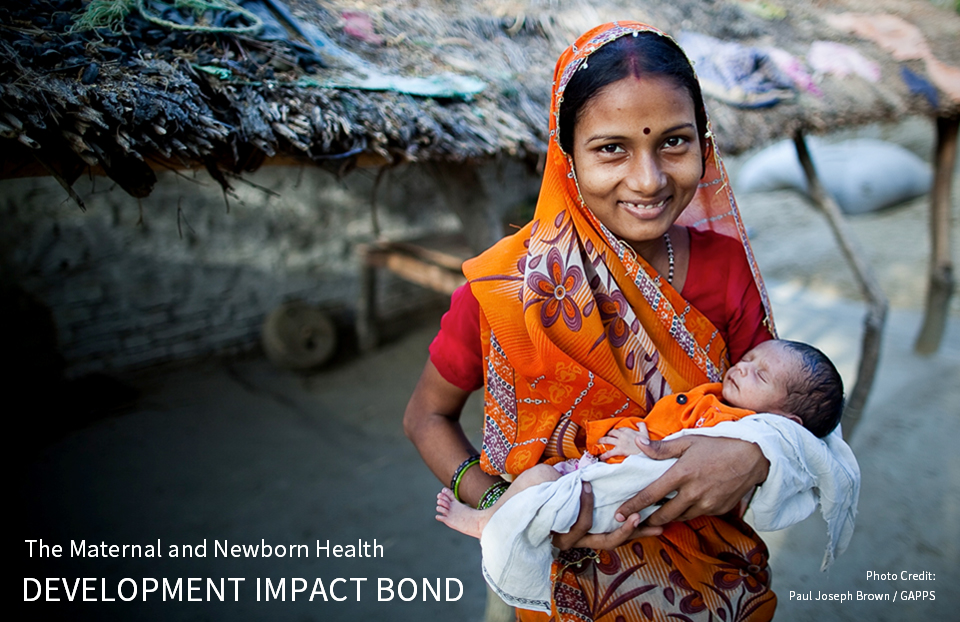
Photo credit: Paul Joseph Brown/GAPPS.
As economies of developing countries grow, governments are better able to finance development programs. USAID is embracing different forms of innovative financing, including leveraging private investment and applying non-traditional approaches to finance the achievement of our goals in global health. USAID launched the world’s first Development Impact Bond in healthcare, focused on improving the quality of care in private health facilities in Rajasthan, India, which has one of the highest maternal and newborn mortality rates in the country. The private sector accounts for more than 25 percent of hospital births in Rajasthan and is used by women across socioeconomic levels. This bond will support government efforts to reduce maternal and newborn deaths by improving access and quality of care in 440 private facilities in the area. With the bond, one investor will pay costs upfront, while USAID and a different donor pay only after milestones are achieved.
- Check out Investing for Impact to see how USAID is applying non-traditional approaches to financing global health
- Read the Financing Framework to Prevent Child and Maternal Deaths
More Countries Access Health Insurance
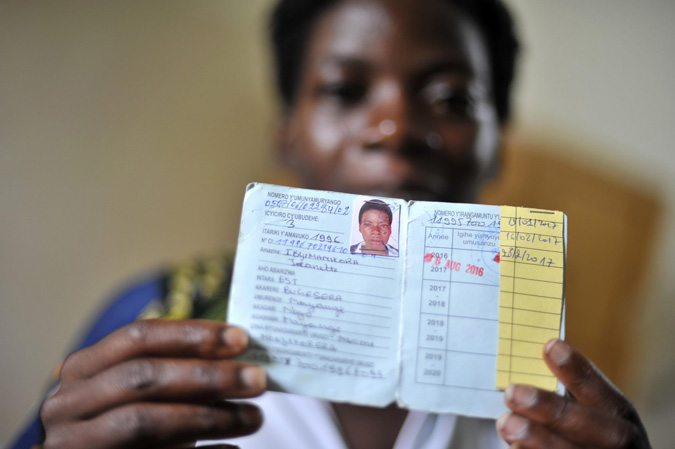
Jeanette Nzayikoreza, a patient at the Manyange Health Centre in Rwanda, shows her medical insurance card. She is six months pregnant and at the clinic for a prenatal care visit. Photo credit: Riccardo Gangale for USAID, Courtesy of Photoshare.
Community-based health insurance, like the Mutuelles in Senegal or Mituweli in Rwanda, are examples of effective health financing that pools resources and risks across a community to provide health services according to people's needs rather than to their individual capacity to pay for them. Community-based health insurance programs such as these help to ensure members of the community are able to access basic benefit packages delivered in health facilities without being deterred by a previously unattainable cost. Increasing access to healthcare by lowering costs means that patients like Jeanette Nzayikoreza in Rwanda are able to get needed care, which can help save their lives.
USAID supports country-driven health financing initiatives to mobilize and leverage sufficient resources to pay for a country’s health needs and reduce catastrophic health costs to individuals, thereby improving access to and availability of services that improve and save lives. By pooling a variety of resources to foster efficiency and equity, ensuring affordability for packages of high-quality, high-impact services, and catalyzing private sector investments in health, countries can improve access to life-saving services.
New HIV Diagnoses Decline in Girls and Young Women in Sub-Saharan Africa
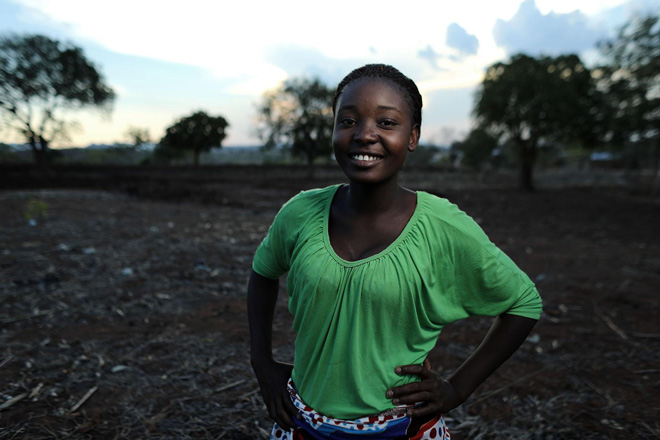
Photo credit: Josh Estey/NAMUH
This year marked the end of the initial two-year DREAMS Partnership under the U.S. President’s Emergency Plan for AIDS Relief (PEPFAR). USAID serves as a key implementer of DREAMS, working to help girls in 10 sub-Saharan African countries develop into Determined, Resilient, Empowered, AIDS-free, Mentored and Safe women. Results from the end of the initial two-year partnership show a 25 percent to 40 percent decline in new HIV diagnosis among adolescent girls and young women in the 10 DREAMS countries. The majority (65 percent or 41 districts) of the highest HIV-burden districts achieved a decline in new diagnoses among adolescent girls and young women ages 15–24 years by more than 25 percent since 2015, including 14 districts that had a decline of greater than 40 percent. New HIV diagnoses also declined in nearly all DREAMS intervention districts.
- Watch Maggie’s Quest to Reach Her Dreams to see how DREAMS is helping a young Malawian and her peers to stay HIV-free.
- View the DREAMS Story Map to read success stories from all 10 DREAMS-supported countries.
GLOBAL HEALTH VOICES
Podcast
PODCAST –"The Link Between Global Health and National Security"
Listen to a podcast conversation with Irene Koek, the Senior Deputy Assistant Administrator for Global Health at USAID.
Download a transcript of this podcast [PDF, 100KB].
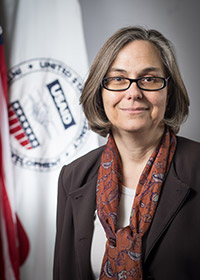
RECENT HIGHLIGHTS
Just Published - December Issue of the Global Health: Science and Practice Journal
The GHSP Journal just published its December 2017 issue. This quarter, the Journal features articles on the risk of HIV acquisition with progestin-only injectables, increasing women’s participation in indoor residual spraying for malaria, use of community health workers to provide long-term care for hypertension in India, and the impact of Farmer Field Schools in the Democratic Republic of Congo. Read these articles and more at www.ghspjournal.org.

